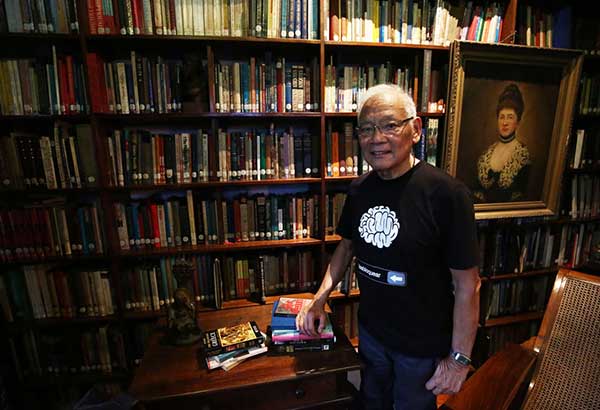Dr. Jaime Laya: Nationalist, art and culture stalwart and book collector

Dr. Jaime Laya at home with his collection of books: “I normally have five bedside books at a time.” Photo BY MIGUEL DE GUZMAN
Did you ever think that those kids who started stamp collections in their childhood would one day become extensive collectors of books, prehistoric artifacts, paintings, furniture, religious images, piña, porcelain and other things?
Dr. Jaime C. Laya, Jimmy to his friends and family, called me one day decades ago asking if I could help find someone who could reproduce the mural by Fernando Amorsolo in the Metropolitan Theater lobby.
It was as owner/curator of Galerie Dominique that Jimmy called and I suggested the late Roger San Miguel, as he needed to complete the project in a couple of months and back then, only Roger could do it faithfully and speedily. That was how I got to know Jimmy.
I looked up to Jimmy as a respectable public official, a nationalist, an authority on culture and the arts, a wonderful dance partner, highly intelligent conversationalist, a perfect gentleman and a sincere friend. Increasingly, I am concerned that this breed has gone the way of the dinosaur.
Over the past, 40 years, Jimmy has remained the same Jimmy I used to know. And I think it is largely due to his confidence in himself, his great appreciation and high regard for learning, and his love for culture and the arts.
One wonders, sometimes: Can accounting and art go hand in hand? Knowing how stereotypes have created images of both, many are not inclined to think so. In Jimmy, it is this synergy between the two that led him to build the Central Bank and Intramuros Administration collections as well as his personal treasury of books, art and artifacts.
Jimmy was only six or so when his father, a schoolteacher, started him off on stamp collecting.
“He gave me a handful of used stamps still stuck on envelopes or on parts of envelopes, no doubt a lesson to get me to learn about other countries, geography, zoology and botany, currencies, history, biography and other things that one can learn from stamps. I eventually concentrated on Philippine stamps, but stopped when I could no longer afford to buy the missing items to fill the blanks in my stamp album,” Jimmy begins.
He also collected coins — the large one-centavo copper coins. However, as coins were issued each year he got bored with them quickly because they all looked alike except for the year. I suppose this is why there are fewer numismatists than philatelists.
His father taught English and his mother, history, so they had a lot of books in the house including a set of Compton’s Picture Encyclopedia that he read over and over, everything from A to Z. That got him fascinated with many subjects and objects.
Undoubtedly, Jimmy is one of our country’s most brilliant minds — indeed knowledgeable in everything from A to Z.
“Being interested in history and being used to reading, I began collecting books on the Philippines when I was in graduate school in California. Hardly anyone was interested in the Philippines there and I had all the secondhand bookshops in the Bay Area to myself. I used to spend Saturdays browsing secondhand bookshops in San Francisco and North to Marin County, East to Berkeley and Sacramento, South to San Jose, all the way to Monterey. I got quite a haul for just one or two dollars each,” he recalls.
He is lucky he started early. Today not even hotdogs can be had for just a dollar. And you know what you can find in dollar stores.
“Back home, I continued collecting books and added other things, mainly santos and paintings. My Lola used to tell stories about the time when she was growing up in Bulacan and so I got fascinated with old furniture and household objects that I began to collect — aparador, paminggalan, chairs, tables, hat racks, etc., much to the dismay of my wife because space was running out,” he adds.
It is a lifestyle that reminds us of a past when furniture pieces were painstakingly crafted by artisans; such items today are few and far between. We lost most of them with the advent of machines in the age of disposables.
“I like to be surrounded with objects that I like or in which I’m interested or that bring back happy memories,” Jimmy declares. This, in effect, sets the framework for Jaime Laya’s collection.
“Collecting also make for good investments. Collectors’ items tend to increase in value. An H.R. Ocampo oil cost me a month’s salary in 1972 and am in shock now to realize that it could fetch a thousand times what I paid (although it’s now with my son in Singapore),” Jimmy says.
There goes the accountant in Jimmy. And I must agree, I’d rather see an H.R. Ocampo on my wall instead of stock certificates in a vault — the latter may never be worth a thousand times what it was paid for.
“Indeed, Ocampos and a few other artists’ works have increased in value far more than shares of stock and other more obvious types of investment,” observes Jimmy.
“Collecting also brings together people with like interests and I enjoy comparing notes with fellow collectors, both personally and on social media. Examples are the Philippine Map Collectors Society (PHIMCOS) and the Oriental Ceramics Society of the Philippines (OCSP). There are a number of Facebook groups focusing on Philippine furniture, old churches, etc., through which one can enjoy, learn and make new friends,” he notes.
There are several thousand books in his house, too, “some old ones, many several decades old, quite a few pocketbooks, my wife’s cookbooks, children’s schoolbooks, even some of my old textbooks etc., The few 18th and 19th century books I have would be the most valuable — I got them cheap, but current values are high,” he muses.
One of his 18th-century books is a religious title written in Spanish by a Franciscan, Juan Francisco de San Antonio from the San Loreto Parish in Sampaloc, Manila that he bought in Amsterdam. Published in 1741, the cover is made of sheepskin, the sheets are made of Chinese rice paper and the sides have a burnt emblem of what we can only guess is a symbol of the Order. He has several of them.
About 20 years ago he had some professional librarians from the National Library catalogue his collection. They are now properly labeled and catalogued using the Library of Congress system.
With the advent of tablets and smartphones, libraries started digitizing their books and information on every topic, making available with just one click. Thus, today’s youth don’t need voluminous collections of books to learn.
“Libraries digitizing their holdings and making these available to everyone is a great idea. It makes knowledge more accessible to everyone. Instead of spending hours (or days when a particular book was so rare that it was found only in some Madrid or London library) looking for a reference, one can do so instantly. We never enjoyed that privilege in our time,” Jimmy says of books available online.
“A book, whether in physical or electronic form, contains the same information. It shouldn’t matter how one gets it,” he adds.
“Take e-books, I’ve read e-books but I like to shift from one section to another and sometimes just look for a few paragraphs that contain the information I want. In some books, I look only for the juicy parts, never mind the rest. Often before I buy a book, I check the ending. I like happy endings so if I like the ending of a particular book that’s the only time I would purchase it. It’s easier to do that in a physical book,” he adds with a laugh.
Developing reading as a habit is a gargantuan task for most kids today, especially if it isn’t encouraged early on. Perhaps some kids are traumatized in their early school years if reading is forced upon them. So they just switch off whenever reading is required.
Jimmy’s advice? “Watch less TV, reduce hanging around and shooting the breeze. Just read. Just do it.” And reading anything that interests you can truly be the start of a productive, fulfilling habit. Perhaps we could add to Jimmy’s advice: play fewer games, tweet and Facebook less.
At a glance, we know what kind of a library Jimmy has built over decades: indeed, one’s book collection allows us to read a man like, well, a book.
Is there a difference between people who read and those who don’t? By nature, extensive readers tend to be able to discuss vital issues, analyze problems, find long-term substantial solutions, engage in research, and express a strong sense of identity and pride as a Filipino.
“People who don’t read probably get their information/knowledge from TV, in conversations, and other forms of mass media,” notes Jimmy. “I suspect non-readers get less input from other peoples’ ideas and findings because they don’t read.”
Asked for his book recommendations for those interested in learning more about Philippine history, he suggested reading books by O.D. Corpuz, Horacio Dela Costa and William Scott.
Asked about what he is currently reading, he says, “I read several books at a time. I normally have about five bedside books that I switch between depending on what I want to read before going to bed.”
Jimmy’s collection of books cannot be measured only in monetary value or the physical space it occupies. It is definitely worth much more if one includes the time and effort that went into its acquisition and cataloguing. Not to mention the acquisition of knowledge, the “companionship” ad fulfillment that his books have provided.
The Dr. Jaime C. Laya library is a pillar of his great legacy.
* * *
Email the author at nikkicoseteng2017@gmail.com or text her at +639974337154.















